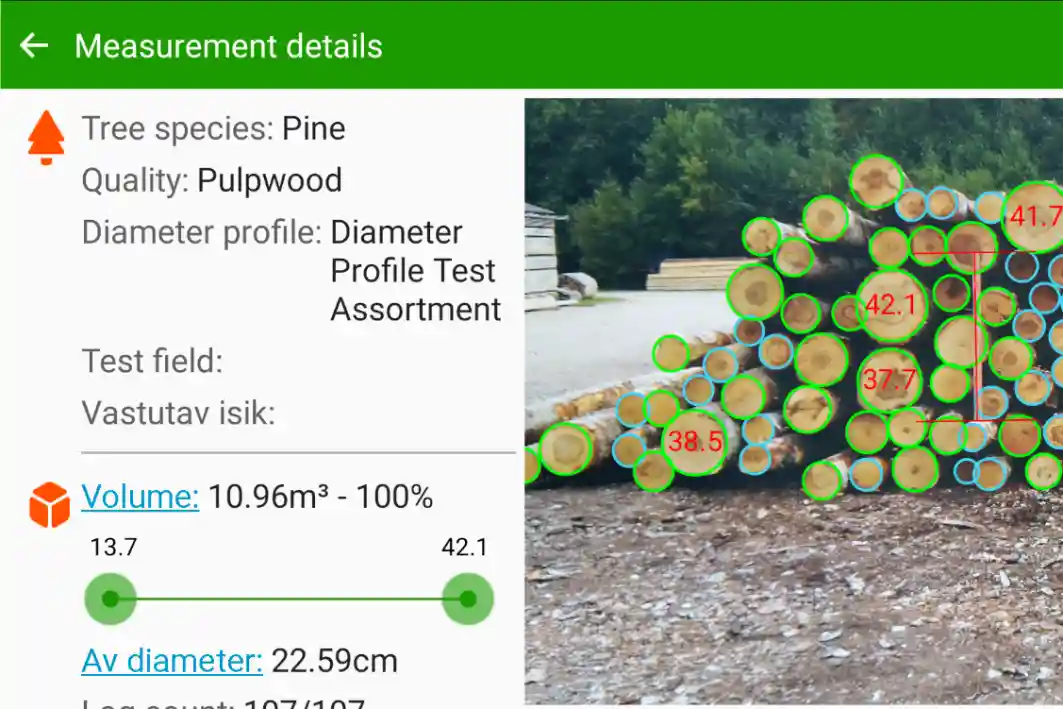The end of the year is when companies usually make their inventories. With Timbeter, the inventories become quick and easy, and you have the precise measurements data in digital format and avoid bad weather, wherever you are.
Measuring one pile manually usually takes at least 30 minutes, not to mention all the paperwork that has to be filled (and therefore can be simply mistaken or lost). With Timbeter, everything is done in only a couple of minutes.
Timbeter offers the possibility to make log-by-log measurements (with “Diameter” regime you can get the diameter of each log, the volume according to the formula you use, and the piece count), pile measurement for pulp or fuelwood measurement (with “Pile” and “Truck” measurement regimes), pile coefficient/density calculation (“Density”) and many other features.
Read an overview of the different options in this article: What are Timbeter’s functionalities and when you should use them
To make sure that you can run your inventories quickly and smoothly, here are 4 points to keep in mind when using Timbeter:
1. Make sure to use the reference stick
2. Choose the correct method (log-by-log or pile method) and the correct formula: do not mix apples with oranges
3. In case of panorama measurement for large piles, keep moving in parallel to the pile and keep the same distance from it
4. Check the results from the Storage module and get the data in Excel or PDF
And here is why it is important to follow the advice for the most accurate measurements:
1. Reference stick
The reference is used for calibrating the measurement results. A reference can be a measurement stick or tape which is a minimum of 1 meter length. The reference needs to be placed on the pile, parallel to it. The reference can be placed horizontally or vertically.
NB! Please make sure that the reference stick is not tilted.
Also, in case of measuring large or long piles, we suggest using longer references (2 or 3 m) for better calibration. You can find out more about the reference in this article.
2. Correct method and formula
With Timbeter, you can use the method for measurement that you are used to in accordance with your region or company’s standards. For log-by-log measurement, use the “Diameter” regime and choose the correct formula (JAS, cylindrical or any other from our selection).
To measure the surface area of the pile, you can simply use the “Pile” measurement regime. To get the volume you can either use your own fixed pile density coefficient/air filling factor* or determine the coefficient with the help of Timbeter with our “Density” regime.
*The coefficient/air filling factor shows how much timber you have without air and bark in a pile.
With Timbeter, you will also have the results in steres.
With this regime, Timbeter also allows marking the pile heights – you can choose the distance (1,3, 5, etc. m) and the starting point from where you want to mark the heights. Check out more from here.
3. Panorama mode
For large piles, Timbeter offers the possibility to make panorama measurements. Always keep in mind that it is always easier to make a single shot from further distance (30 to 50 meters will work perfectly) compared to panorama mode that needs more attention. The most important thing is to move in parallel to the pile, not back and forth, and keep the same distance from the pile throughout the measurement otherwise the results can be distorted.
4. Storage Module and reporting
All the measurements-related data is carefully stored in the Storage Module, our cloud data storage.
To access your Storage module, login from the timbeter.com page with the credentials (email address and password) you used during registration, then you will see all the measurements that you have made. With Timbeter’s Storage module, you can analyze and filter the data and download the information in Excel or PDF: to learn more about the possibilities, click here.
Besides that, all the data can be synchronized via API (for more information, please contact our customer support service).
Useful tips:
1. We suggest setting your storages and the assortment plan before you start measuring. The preset assortments and storages will significantly reduce the time spent on measurements and the data processing, improving your reporting system.
2. You can add the assortments with your Storage module: press the main menu button and choose “Timber” – “Wood assortments” – add a new assortment. When adding an assortment, you can include the data regarding the species, wood quality, log length, minimal and maximal diameter and the price. Once the assortment plan is set, the above-mentioned parameters will be automatically added to the measurement settings after choosing a particular assortment for your measurement.
3. You can also number piles and pile sections in advance for a more convenient reporting process; the information regarding piles and pile sections can be added in “Comments” filed in the application; this data can be also easily transferred via API
Before going to the log yard, make some tests or go through the tutorial, so you can be sure that you have understood everything correctly.
If you have any questions or difficulties, contact our customer support team via info@timbeter.com to get the help!
